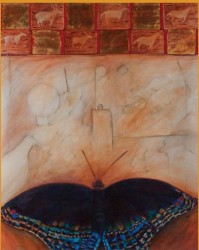Article Origin
Volume
Issue
Year
Officials from Banff’s Whyte Museum of the Canadian Rockies are anticipating large crowds for their latest exhibit called Indigenous Ingenuity.
“I think it’s going to appeal to a lot of people,” said the museum’s curator Anne Ewen, adding it won’t just be Aboriginals, who will be drawn to the exhibit.
If the exhibit opening, which was held on June 15 is any indication, then Ewen will be correct with her prediction. About 350 people attended the opening.
One reasons Ewen believes the exhibit, which continues until Oct. 19, will be a huge success is because it includes both old and new art.
“It was important to combine the historical elements with the contemporary pieces,” she said. “And it is a unique component, for the exhibit to combine historic artifacts with contemporary work.”
Numerous historic artifacts, which are from the Whyte Museum collections, are on display and help to highlight materials, techniques and motifs used by Indigenous peoples.
Ewen added there were three main reasons why museum officials decided to stage the Indigenous Ingenuity exhibit now.
For starters, this year marks the fifth anniversary of the death of artist Joane Cardinal-Schubert, who was known not only nationally but internationally for her artistic works and advancement of Indigenous art in the country.
Cardinal-Schubert, who was a painter, installation artist, writer, curator, poet, lecturer, mentor and director of video and native theatre, addressed social and political injustices in her works.
She was also a member of the prestigious Royal Canadian Academy of Arts.
A portion of the exhibit, which honours Cardinal-Schubert, is an installation piece that talks about residential school life.
Ewen said the other reasons for staging this exhibit were to honour those artists who inspired and mentored Cardinal-Schubert, who was also a member of the Order of Canada, and then also showcase work from those artists who received motivation from her.
The exhibit features about 150 pieces of work.
“I’m blown away,” Ewen said of the artwork on display. “I’m gob-smacked if you will.”
This includes art from all of the members of the Indian Group of Seven, which consists of Jackson Beardy, Eddy Cobiness, Alex Janvier, Daphne Odjig, Norval Morrisseau, Carl Ray and Joseph Sanchez.
Other well-known artists who have pieces in the exhibit include Carl Beam, David Garneau, George Littlechild and Jane Ash Poitras.
The Whyte Museum of the Canadian Rockies opened in 1968.
The founders of the facility are Catharine Robb and Peter Whyte, who met at the Boston Museum School of Fine Art in 1927 and married three years later.
Whyte was a member of one of Banff’s pioneer families. After their marriage they built a studio in Banff where they both painted extensively.
The museum opened two years after Peter’s death. Catharine remained involved in the facility until she died in 1979.
The museum, which is open seven days a week, does not have a set admission fee. Museum officials suggest a donation.
Photo caption: Joane Cardinal-Schubert, Flutterby (Birchbark Letter),
1998, mixed media on canvas, 120 x 99.5 x 3.5 cm, collection of Alberta
Foundation for the Arts.
- 1238 views

